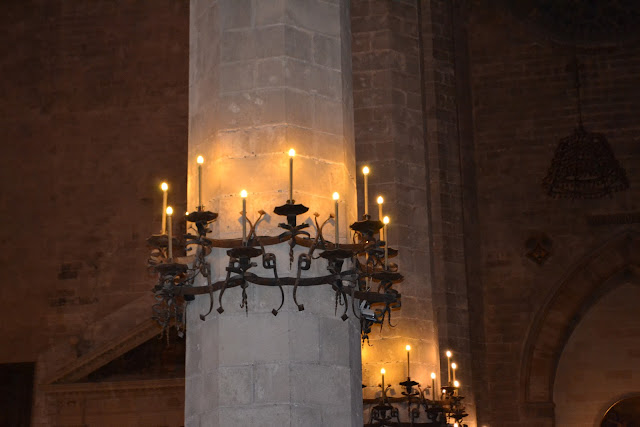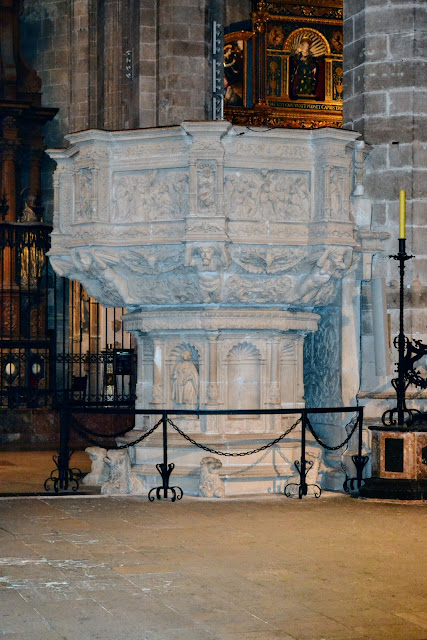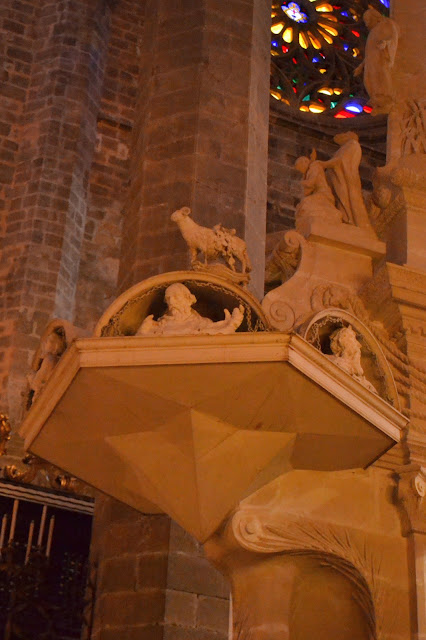We spent our 7th day in Palma de Mallorca, capital and largest city of the Balearic Islands in Spain.
We started out at Bellver Castle, built in the 14th century for King James II.
As this picture shows, Bellver is a circular castle. Used for centuries as a home for the kings of Mallorca, it became a military prison during the 18th-20th centuries.
Now the castle is one of the top tourist's sites, civilian owned, and home to the History Museum.
Sadly, this was yet one more place we did not have time to see inside.
Rock from the hill the castle was built on is the source of building material.
As a military prison, it was used mainly to hold political prisoners.
The circular building produces
The castle also has a nice moat, crocodiles not included.
Because of its location, Castle Bellvar is visible from nearly everywhere in the city.
It does have a few cracks and missing bricks.
Being 600 years old guarantees a nearly constant restoration effort.
Our next stop is Palma Cathedral (Le Seu).
Legend says James I was on his way to the island in very rough and dangerous seas. James vowed that if he could rid the island of the Moors he would build a cathedral, making sure it was a highly visible reminder of his success.
Palma Cathedral is Gothic, Roman Catholic, and construction started in 1229.
Construction didn't end until 1601.
The site was already a mosque, but when James defeated the Moors it became the chosen spot for his promised church. The actual main architect is unknown, mostly because so many men worked on it over the years.
Ironically, anyone kneeling to pray at the altar faces Mecca.
At one time the sea reached the city walls. When a road was constructed in 1960, that changed. A public park called Parc de la Mar was constructed at that time
The park has become a favorite spot for locals.
The park has a modern sculpture
that looks a little angry.
Next to the cathedral is the Royal Palace of La Almudaina.
Originally built as an Arab fort, it was transformed into a residence for royalty.
The Palace.
There are a number of gardens and sculptures, part of Parc de la Mar.
Es Foner, an 1898 bronze by Lorenzo Rossello depicts a Phoenician warrior with a catapult sling. According to our guide, the early Roman settlers were expect sling-shooters.
Gardens of Parc de la Mar.
Nancy by Alexander Calder created in 1971.
Monument by Joan Miro.
Untitled by Amadeo Gabino.
Hillargio by Jorge Oteiza
My favorite: Device to Root Out Evil by America sculptor Dennis Oppenheim.
Yes, because this place clearly needs more pigeons.
Back to Palma Cathedral.
The Cathedral is said to encompass all artistic styles since the Middle Ages.
The Cathedral has three entrances.
The western side of the Cathedral is the most elaborate, the most Gothic.
The Cathedral was heavily damaged during an 1851 earthquake, causing the main facade to almost collapse.
The north side bell tower.
The south door.
This entrance was originally called "The Apostles Door" because of its depiction of the Last Supper.
It's now the known as the Mirador (lookout) door. This door faces the ocean.
Another entrance, the north wall.
Random gargoyle to the left.
A lot of the windows were this pretty shade of blue.
More gargoyles, originally intended to be rainwater spouts, but also serving the purpose of reminding viewers of the horrors of hell if they did not repent.
The west entrance to the Cathedral.
The Virgin Mary is placed above the west entrance. This entrance was the only door to survive the 1851 earthquake.
One of the famous rosette windows.
Peeking through the west door, viewing a circular stained glass window.
The sides of the entrance were the most interesting part of this entrance.
John the Baptist.
More of the pretty blue.
A slightly worn religious leader.
Mary has a really great halo.
I've heard of graying beards but greening beards are new to me.
A particularly mournful figure.
A view of one of many flying buttresses.
There are five apostle figures on the Cathedral.
I only have pictures of four.
Angel atop a spire.
That's pretty much all I know about the exterior. Time to move inside.
Oops
I got a little distracted.
Here we go!
This rose window is the largest in the world. It is 39+ feet across, with 1236 pieces of glass.
Gaudi (of Sagrada Familia fame) is the designer of the stained glass. Gaudi was brought on in 1901 to repair damage done in the 1851 earthquake.
Gaudi was experimenting with a new technique in making stained glass that involved superimposing red, yellow, and blue glass pieces. He wanted to test the method before installing it in his masterpiece, Sagrada Familia.
Gaudi quit in 1914 when he had a disagreement with the contractor.
The gold work below this window is the 1420 altar piece. It was removed and stored in the 18th century. When Gaudi became involved, he moved it to this spot.
A view into the nave.
The stained glass windows added by Gaudi considerably lighten the interior of the Cathedral.
It's challenging to get a good picture of stained glass
I particularly like the colors and design of this window.
The Chapel of the Holy Sacrament, remodel in 2007. The modern glass was added at that time, making it one of the very few non-Gaudi stained glass windows.
Gaudi's style was influenced by the Art Nouveau movement. I think this window is a good example of Gaudi's version of Art Nouveau.
The Cathedral has 61 stained glass windows.
The lights are also creations of Gaudi, both the hanging light and the light around the pillar.
The Palma Cathedral can hold 18,000 people.
Close-up of Gaudi light.
This Cathedral is the final resting place of kings, Catholic leaders, and important local people.
Organ pipes, dating to 1795
Beyond the pipes is the Chapel of Piety.
The Pulpit of the Gospel 1529-1531, is in the form of a goblet. On the base are six lions.
Around the top portion are depictions of the Seven Gospels of Mary.
The clock is strategically located across from the pulpit so the priest can keep an eye on the time.
The second pulpit is also from the 16th century, Renaissance style.
Both of these pulpits were made by Juan de Sales
An elaborate confessional.
The high altar at La Seu. The alabaster sarcophagus at the bottom of the altar contains the remains of St Eulalia, the young girl martyred for her belief in Christ in 304 AD. The tourist wiping away a tear is temporary and surprisingly young in comparison to the rest of the Cathedral.
This is an interesting sarcophagus. I wish I could find out more information about it. Inside the circle on the front is some information that is impossible to read, other than a few letters and the year 1806.
St Jerome altarpiece from the 17th century, patron saint of librarians, translators, and encyclopaedists.
The 18th century baptismal font, made from a single piece of red stone.
The cloister of Palma Cathedral.
We took a quick look into Saint Antoni de Viana.
St Antoni was built as a convent and hospital in 1230,
In 1757-1768 the current church was built.
This church has beautiful marble floors
walls, and ceilings.
St Antoni was born in 1195 and was known for his preaching, knowledge of the scriptures, and devotion to the sick and poor.
If you can't find gelato, Italian desserts will do in a pinch.
We fine dined at this restaurant where every picture was of the same woman.
Someone really liked her.
We strolled by this interesting tree.
It's an olive tree, around 800 years old. It's a delicate 22 feet in diameter and roughly 19.5 feet high.
Amazingly, it still produces fruit.
Our final stop was the Son Amar show.
We got a traditional Spanish lunch, complete with a fruity juice that tasted like dirty gym socks. Note to self: do NOT taste the fruit juice they called "sangria".
The show was a lively traditional singing
and Flamenco dancing.
Flamenco dancers do a lot of very graceful stomping around.
That night we discovered the disadvantage of have a balcony room. We liked to prop our door open at night for some air, like you see in this picture. I woke up in the middle of the night to the sound of a fluttering bird. At 2 am Stan and I were running around the room, trying to get a small brown bird to go out. I hope he found his way to land.
























































































































I love the modern sculpture garden in the midst of the ancient buildings, and I especially like the very cool upside-down house, which reminds me what it was like to raise children. The Palma Cathedral is stunning, and I especially liked the carving of John the Baptist on the exterior, the beautiful Gaudi windows and lights inside, and that St. Jerome altarpiece. What a find! Now I want to go to Palma!
ReplyDeleteI loved seeing Mallorca. The castle and cathedral look fantastic. It has kind of a barrenness about it that is distinctive.
ReplyDelete